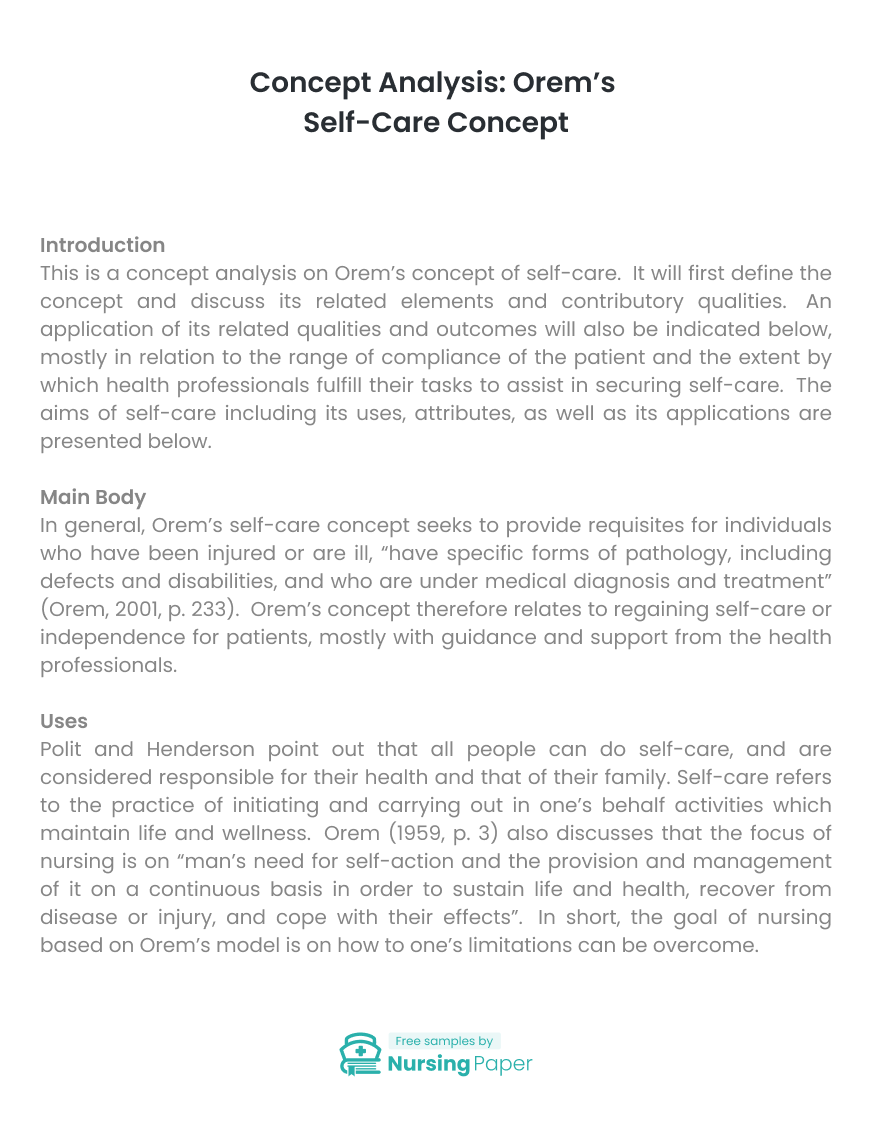1. Abotalebidariasari, G., Memarian, R., Vanaki, Z., Kazemnejad, A., & Naderi, N. (2017). Self-care agency power components among patients with heart failure: A qualitative directed content analysis based on the Orem Self-Care Theory. Journal of Critical Care Nursing, 10(1).
2. Ailinger, R. L. & Dear. M. R. (1993). Self-care agency in persons with rheumatoid arthritis. Arthritis Care and Research, 6 (3), 134-40.
3. Chen, A. M., Yehle, K. S., Albert, N. M., Ferraro, K. F., Mason, H. L., Murawski, M. M., & Plake, K. S. (2014). Relationships between health literacy and heart failure knowledge, self-efficacy, and self-care adherence. Research in Social and Administrative Pharmacy, 10(2), 378-386.
4. Chunyi, J., Ying, Y., & Juan, H. (2014). Effect of Orem self-care pattern on quality of life of patients undergoing radiotherapy after breast cancer operation. Modern Clinical Nursing, 2, 013. Current Nursing (2012). Dorothea Orem’s Self-Care Theory. Retrieved from http://currentnursing.com/nursing_theory/self_care_deficit_theory.html
5. Edney, K., Jaime, N., & Young, L. (n.d). Dorothea Orem’s self-care theory. Retrieved from https://sites.google.com/site/oremstheory/home
6. Evers, G. C. M., Isenberg, M. A., Philipsen, H., Senten, M., & Brouns, G. (1993). Validity testing of the Dutch translation of the appraisal of self-care agency ASA scale. International Journal of Nursing Studies, 30 (4), 331-42.
7. Folden, S. (1993). Effects of a supportive-educative nursing intervention on older adults’ perceptions of self-care after stroke. Rehabilitation Nursing, 18 (3), 162-7.
8. Jaarsma, T., Riegel, B., & Strömberg, A. (2017). Reporting on self-care in research studies: Guidance to improve knowledge building. Journal of Cardiovascular Nursing, 32(4), 315–316
9. Lukkarinen, H. & Hentinen, M. (1997). Self-care agency and factors related to this agency among patients with coronary heart disease. International Journal of Nursing Studies, 34 (4), 295-304.
10. Monsen, R. B. (1992). Autonomy, coping, and self-care agency in healthy adolescents and in adolescents with spina bifida. Journal of Pediatric Nursing, 7 (1), 9-13.
11. Orem, D. E. (1990, 2001). Nursing concepts of practice. Mosby: St. Louis.
12. Orem, D. E. (1959). Guides for developing curricula for the education of practical nurses.
13. Washington, DC: Government Printing Office. Polit, D. F., & Hungler, B. P. (1995). Nursing research: Principles and methods (5th ed).
14. Philadelphia: J. B. Lippincott Company.
15. Shahdadi, H., Dahmardeh, H., Salari, S., & Ahmadidaresima, S. (2017). The effect of a self-care training program based on Orem Model on anxiety in patients with multiple sclerosis (MS). Indian Journal of Public Health Research & Development, 8(1).
16. Shrivastava, S. R., Shrivastava, P. S., & Ramasamy, J. (2013). Role of self-care in management of diabetes mellitus. Journal of Diabetes & Metabolic Disorders, 12(1), 14.
Silva, J. S. (2014). The Orem theory and its applicability in chronic renal patient care/A Teoria de Orem e sua aplicabilidade na assistência ao paciente renal crônico/La Teoría de Orem y su aplicabilidad en la atención al paciente crónico renal. Revista de Enfermagem da UFPI, 3(3), 105-8.
17. Sitzman, K., & Eichelberger, L. W. (2004). Dorothea Orem’s Self-Care Model. Understanding the work of nurse theorists: a creative beginning, 81.
18. Sousa, V. (2002). Conceptual analysis of self-care agency. Online Brazilian Journal of Nursing, 1(3).
19. Wong, C. L., Ip, W. Y., Choi, K. C., & Lam, L. W. (2015). Examining self‐care behaviors and their associated factors among adolescent girls with dysmenorrhea: An application of Orem’s self‐Care deficit nursing theory. Journal of Nursing Scholarship, 47(3), 219-227.

The download will start shortly.






 Subject:
Subject:
 Number of pages: 6
Number of pages: 6